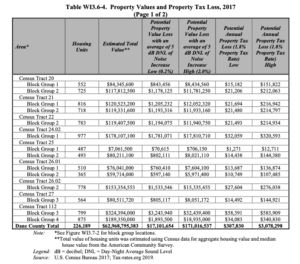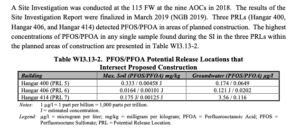Up to $3M in lost tax revenues, up to $171M in lost property value, PFAS levels that exceed drinking water standards of 70 parts per trillion and more.In addition to summarizing the bigger issues in the EIS and the responses to the comments from the public, I attempted to compare the roughly 140 Madison specific pages of the draft EIS from August to the final EIS released this week. Very little had changed. But what did is somewhat significant. I did a very quick review and it appears that not all the information is yet available. I’m still looking for Appendix B! These are the types of items I wish our media had reported on, instead of the massive media fail. They have much more resources to figure this stuff out!
NEW INFORMATION ABOUT LOSSES IN TAX REVENUES AND PROPERTY VALUES
Looks like people could lose $17M – 171M in property value, with their conservative estimates.
That would mean $300K – $3M in property tax loss – annually, again, with the conservative estimates.
Who is going to pay for that?
On page 77 and 78 they have this new language
Property values are a function of many different variables, including noise levels. The issue of the negative effect of airport noise on property values has been widely researched. A more full discussion of the impacts of noise levels on property values and resultant real estate taxes is contained in Appendix B, Noise Modeling, Methodology, and Effects. The property value to noise effects relationship is presented in the form of the Noise Depreciation Index (NDI), which reflects the estimated percent loss of property value per dB DNL (see Section 3.2.2). A review of several relevant studies (see Appendix B) concludes that noise may affect property values and related taxes in a NDI range of 0.2 to 2.0 percent per dB of noise increase, which correlates to an average loss of 0.5 percent of the property value per dB. The value of the property is determined based on many individual variables which, when taken together, form the total price and requires detailed information on local housing markets and actual sales prices. Furthermore, price property value studies model relationships between city level income and population data, and the overall willingness to pay for noise abatement, which enables an estimate of noise impacts in locations where detailed housing data is not available. The cost of noise mitigation is less of a factor in regions that experience extreme temperatures. Many structural elements designed to improve energy conservation also improve the acoustic performance of homes. The way properties are used in hot or cold environs (such as not opening windows for ventilation) can add as much as 15 dB of noise mitigation. The anticipation of noise level increase may also influence property values before the noise increases actually occur.
The range of impacts provided in Appendix B of 0.2 to 2.0 percent per dB serve as a rough estimate of potential impacts. These impacts will vary from location to location depending on the many other factors that influence property value including local market conditions.
If an area does in fact suffer from lower property values associated with increased noise levels, this will result in lower property taxes collected. Over time, lower sales prices in these areas will result in lower appraised values.
Table WI3.6-4 shows estimates of total property values and taxes in the census block groups within the 65 dB DNL contour line. Conservative estimates are shown giving a range of potential property value loss due to increased noise levels and the resulting range of potential property tax losses. These estimates assume that houses in the block groups within the 65 dB DNL contour line are exposed to 5 dB DNL increase in noise. As shown in Table WI3.1-10, POIs surrounding Dane County Regional Airport would experience marginal noise increases ranging from 0 to 9 dB DNL. As a result, an average of 5 dB is used.
I haven’t found appendix B. I’m guessing its not released yet?
EIS Documents
This section contains all documents that have been released to date related to the Environmental Impact Statement. As new documents are released, they will be posted here.
Final EIS
Final F-35A EIS Executive Summary February 2020
Final F-35A EIS Vol I February 2020
NOTE: Due to the large size of the document, we have also broken down the EIS into several parts that can be downloaded separately.
Final F-35A EIS February 2020 Vol I Part 1
Final F-35A EIS February 2020 Vol I Part 2
Final F-35A EIS February 2020 Vol I Part 3
Final F-35A EIS February 2020 Vol I Part 4
Final F-35A EIS February 2020 Vol II
NEW INFORMATION ABOUT PFAS
page 121 – new language and chart.
The highest concentrations of PFOS/PFOA in any single sample found during the SI in the three PRLs within the planned areas of construction are presented in Table WI3.13-2.
Make sure to pay attention to this note:
Notes: 1 μg/l = 1 part per billion = 1,000 parts per trillion.
Modified language on page 124
Three PFOS/PFOA PRLs including Hangar 400, Hangar 406, and Hangar 414 overlap with the proposed construction at the aforementioned Hangars (Figure WI3.13-4). The 115 FW will comply with Air Force Guidance Memorandum (AFGM2019-32-01) AFFF-Related Waste Management Guidance to manage waste streams containing PFOS/PFOA (USAF 2019). The AFGM will be updated as needed to address changes in regulatory requirements, DoD determinations of risk, or development of new technologies.
New language on page 127
Per the Site Investigation Report, no soil samples exceeded the USEPA risk-based screening level for PFOS/PFOA within the planned construction area. Groundwater samples for PFOS/PFOA exceeded the USEPA Lifetime Health Advisory of 70 parts per trillion (ppt) for drinking water at all three locations within the planned construction area. The next step in the CERCLA process is the Remedial Investigation. During the Remedial Investigation, the agency will collect detailed information to characterize site conditions, determine the nature and extent of the contamination, and evaluate risks to human health and the environment posed by the site conditions by conducting a baseline ecological and human health risk assessment. The CERCLA process will continue regardless of any construction activities. Construction activities, to include the handling, mitigation, and disposal or other disposition of contamination discovered before or during the construction activity, will proceed in accordance with all applicable legal requirements.
NOISE – MITIGATION TBD
page 43 – language added
A Mitigation and Monitoring Plan will be developed for those installations chosen, and will include metrics to track and monitor those activities that are identified to minimize the impacts. These could include afterburner usage, flight tracks, number of operations, etc. The Mitigation and Monitoring Plan will identify who is responsible for implementing specific mitigation procedures, who is responsible for funding them, and who is responsible for tracking these measures to ensure compliance.
FUEL DUMPING
page 61 – language added
For use in emergency situations, certain aircraft have the capability to jettison fuel and reduce aircraft gross weight for flight safety. When circumstances require, fuel jettisoning is permitted above 5,000 feet AGL, over unpopulated areas, and is generally over water for applicable bases. Air Force Instructions (AFIs) cover the fuel jettison procedures, and local operating policies define specific fuel ejection areas for each base. The F-16 can only jettison fuel by jettisoning the external mounted fuel tanks.
ACCIDENTS, ER “MISHAPS”, AND FIREFIGHTING
page 62 – language updated
Through Fiscal Year (FY) 2019, the F-35A has amassed 96,313 flying hours with three Class A mishaps resulting in no injuries and a Class A mishap rate of 3.11 lifetime, and for the last 5 years of 2.17 (AFSEC 2019b). These statistics are updated annually. Because the F-35A has not yet reached 100,000 hours by the end of FY 2019, this rate is not directly comparable to other aircraft with more flying hours. However, this rate does provide some indication of the overall safety of the F-35A aircraft. For example, this rate is much lower than the 18.65 rate that the F-16 had in the past after a comparable amount of hours.
page 64 – changed language
Chapter 3, Section 3.5.1.1 details F-35A composite material characteristics and potential exposure risks. Under the Proposed Action, firefighters would continue to be fully trained and appropriately equipped for crash and rescue response involving advanced aerospace composite materials and the proposed 115 FW F-35A beddown would not change these abilities. Additionally, 115 FW would keep local firefighting departments informed about any new information or firefighting techniques associated with composite materials should an accident occur. Based on current information on the characteristics of burning composite materials, standard firefighting equipment, including self- contained breathing apparatus, should be adequate to protect firefighters (Air Force Research Laboratory 2015; Naval Air Warfare Center 2003). No special extinguishing agents are needed for composite materials and typical aircraft firefighting agents, such as water or aqueous film forming foam, are adequate to control burning composite materials during an aircraft mishap. In the event of a crash of an aircraft containing composite materials, the USAF would follow the guidance contained in the Mishap Response Checklist for Advanced Aerospace Materials/Composites (USAF Advanced Composites Program Office 1993).
The only maintenance of the stealth coating (e.g., low observable material) that would be accomplished at the base would be done using a brush or roller to apply coatings, bonding materials, or applying tape. Depot-level maintenance of the low observable material (including spray capability) would be conducted off-site, and therefore the composite material for major repairs to the low observable material would not be stored on base.
The F-35A does have the capability to jettison fuel for emergency situations. When circumstances require, fuel jettisoning is permitted above 5,000 feet AGL, over unpopulated areas, and is generally over water for applicable bases. AFIs cover the fuel jettison procedures, and local operating policies define specific fuel ejection areas for each base. In 2001, the USEPA National Vehicle and Fuel Emissions Laboratory concluded, “Since fuel dumping is a rare event, and the fuel would likely be dispersed over a very large area, we believe its impact to the environment would not be serious” (USEPA 2001). The F-35A’s ability to dump fuel as an alternative to the jettison of external fuel tanks, as with the F-16, would be less impactful to the environment.
This is the language they removed (Thanks to Maria Powell from MEJO for pointing out the removed language):
“The F-35A aircraft has a 42 percent composite material by weight, while the F-16 aircraft has 13 percent. One disadvantage of composite materials is that they have the potential to degrade under extreme temperatures, resulting in the production of toxic fumes and airborne respirable fibers. Laboratory studies have identified respirable fiber products and toxic gases (including high levels of CO, NOx, and hydrogen cyanide) from burning composite materials. Because of these characteristics, composite aerospace materials present unique hazards to mishap responders. Individuals exposed to a crash site could experience dermatological and respiratory problems. Exposure to these hazards would not necessarily end when a fire is extinguished; exposure to recovery crews, site security, the surrounding population, and others could continue (Naval Air Warfare Center 2003). However, research on aircraft composite materials similar to that used on F-35A aircraft demonstrate that combustion characteristics of composite materials are similar to other combustible materials and rapid flame spread or excessive heat releases are not a concern. Additionally, data and experience from several crash responses indicate that single fiber concentrations are typically very low, and a very specific and rare set of conditions is needed to produce airborne carbon fires. Due to the rarity of mishaps involving composite aerospace materials, no epidemiological data are available on personnel exposure to burning composites, and no studies have assessed the toxicology of carbon fibers generated in fire scenario with extended post-exposure duration.”
CLOSING SCHOOLS AND ELDERLY POPULATION
page 84 – Language added.
however, the USAF does not anticipate it would be necessary to close any schools as a result of a basing decision. Interference with classroom speech is discussed in detail in Chapter 4, Section WI3.1.1.2. It is important to note also that most permanent structures, including school buildings, can be effectively insulated from any distracting, exterior noise. Such mitigation is available from the FAA’s noise mitigation programs and other sources. Further information on impacts associated with noise can be found in Section WI3.1.
Elderly Populations
Older adults have been identified as sensitive receptors to potential adverse impacts due to physiological and behavioral changes that come with age (Air Force Civil Engineer Center [AFCEC] 2014). Table WI3.7-1 shows the percent of the populations of the block groups that are elderly. Most of the 13 block groups that would be exposed to noise levels of 65 dB DNL or higher have a lower percentage of elderly people than the city of Madison and Dane County as a whole, however, 4 of the block groups have a higher percentage of elderly people.
A review of nursing homes and assisted care facilities found that one location would fall within the 65 dB DNL contour (Homeland Infrastructure Foundation-Level Data 2019). The one location identified is Women in Transition, which is a mental health center and does not contain a concentration of elderly residents. Because most of the impacted block groups do not contain a higher proportion of elderly residents than the surrounding region and there are no nursing homes or assisted living facilities for the elderly in the impacted areas, impacts to the elderly would not be disproportionate and would be minor.










Thank you for taking time to review the Final EIS. If you are still looking for Appendix B, it is inside this document: Final F-35A EIS February 2020 Vol II
Thanks! I swear I didn’t see it, I only saw Appendix A!